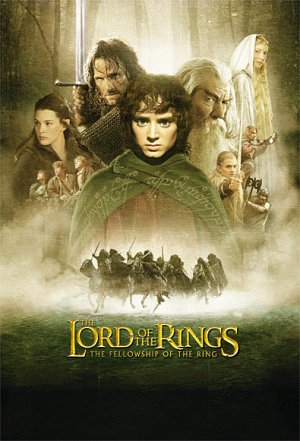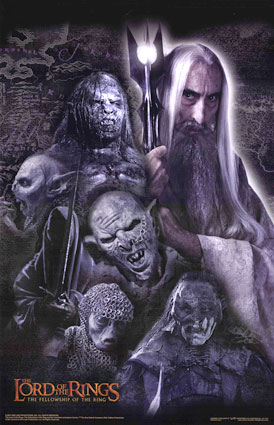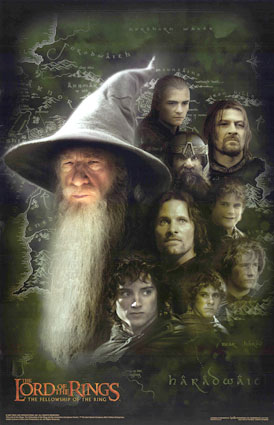The Lord of the Rings
The Fellowship of the Ring
movie review by G. S. Reis
 I've read The Lord of the Rings trilogy and its prelude, The Hobbit. And although the Tolkien Calendar hangs on my wall, I don't consider myself a real fan. But I'm a fantasy enthusiast, and my expectations toward the movie were huge. The same way, I could leave the theater hugely disappointed. I did not. I will not commit what true fans would see as a heresy, by stating that the movie is better than the book. But I can say, with absolute certainty, that I enjoyed the movie most. And that's different.
I've read The Lord of the Rings trilogy and its prelude, The Hobbit. And although the Tolkien Calendar hangs on my wall, I don't consider myself a real fan. But I'm a fantasy enthusiast, and my expectations toward the movie were huge. The same way, I could leave the theater hugely disappointed. I did not. I will not commit what true fans would see as a heresy, by stating that the movie is better than the book. But I can say, with absolute certainty, that I enjoyed the movie most. And that's different.
Almost 50 years were needed for the special effects technology to develop enough to portrait J. R. R. Tolkien's fantastic imagination in a realistic way, not resorting to the animation format, like Ralph Bakshi did in 1978. Also needed was the enthusiasm of a fan, director Peter Jackson, for should it depend on the narrow sights of Hollywood executives, the movie would probably never exist.
If anyone does not know the story yet, here it goes, in very general lines: Frodo, a hobbit, a small being with furry feet, carries an evil ring which may give the Dark Lord absolute power. Guided by the wizard Gandalf and aided by representatives of the races of Men, Elves and Dwarves, he must take the ring to be destroyed at the same place it was forged, in the middle of the enemy's territory, facing all sorts of monsters along the way, including the horrible Orcs. Said so, it sounds simple, but there is much more than just "the eternal struggle between Good and Evil," as the unaware spectator might think. Tolkien has created a complete world of fantasy from Old legend and folklore of Old Europe, with maps, peoples, cultures, languages and History.
Peter Jackson chose to keep the trilogy format and convinced a relatively small studio, New Line Cinema, to boldly finance the production of the three movies, all at once in order to reduce costs. He shot everything on his homeland, New Zealand, and grants us large doses of its wonderful landscapes, complemented by fantastic sets, both real and virtual. Frequently, we see the characters close to us, and then the view enlarges to show the entire wideness around.
 The special effects, brought by Jackson's own company, must have shut up the jealous George Lucas, who had said only his Industrial Light & Magic could give life to Middle-Earth. But unlike his The Phantom Menace, here the effects only serve the story, never overcome it. It deserves mentioning the perfect height reduction of actors who play hobbits and dwarves, which even makes one forgets it is a special effect. The excellent make-up shapes over 200 orcs, each one unlike any other. Also, I must highlight the presence of Alan Lee and John Howe, two of the most famous Tolkien's illustrators, as conceptual artists.
The special effects, brought by Jackson's own company, must have shut up the jealous George Lucas, who had said only his Industrial Light & Magic could give life to Middle-Earth. But unlike his The Phantom Menace, here the effects only serve the story, never overcome it. It deserves mentioning the perfect height reduction of actors who play hobbits and dwarves, which even makes one forgets it is a special effect. The excellent make-up shapes over 200 orcs, each one unlike any other. Also, I must highlight the presence of Alan Lee and John Howe, two of the most famous Tolkien's illustrators, as conceptual artists.
The screenplay carries the essence of the book and fans will recognize many dialogues, transposed word by word. There will ever be those who will complain about cut-off passages, but the movie lasts three incredibly short hours and perhaps some other three would be necessary just to contain all the events of this first part. Jackson cut off what was needed in order to make a coherent film that would not look truncated. He left out the Old Forest and Tom Bombadil, both of which have little or no influence in the future happenings, whereas the journey across the Mines of Moria is properly highlighted. Small changes were made here and there, but they don't harm the adaptation at all and looked pretty right to me. The main one is the growth of Arwen's part, who barely appears in the book, and her romance with Aragorn, originally mentioned only near to the end of the story. Exciting duels of the wizards were added. And there are proper modifications to the narrative time line: in the book, many events are told by the characters themselves, long after they have occurred; in the movie, just Gandalf's escape from the tower is shown in flashback, which could have been avoided.
In synthesis, Jackson manages to be loyal to Tolkien, without becoming his slave. Far from the pressure of a big studio, he had freedom to do whatever he wanted, and he did it with surprising mastery. His direction only fails in a few moments in the battle scenes - which are excellent, even spectacular, but sometimes, at the guise of transporting the audience to the core of the battlefield, the camera moves too much, in a foolish resort that only serves to make it harder to understand what is happening on the screen. However, before the talent shown in everything else, that flaw is easily forgivable. So are the grotesque transformations of Bilbo and Galadriel before the temptation of the Ring: even for those who have read the book, it's hard to realize they are more in Frodo's vision, distorted by the Ring. There are really moving moments: one, when leaving Moria, brought me to tears (an extremely rare thing), so much I was involved by the film.
 The cast was well chosen and well directed. Ian McKellen is Gandalf, period. Sean Bean as Boromir, divided between the loyalty to his fellows and the temptation of the Ring, stands out, too. Elijah Wood may not be brilliant, but correctly shows the burden of the Bearer of the Ring. There is still the charismatic presence of the eternal Count Dracula, Christopher Lee, in a perfect personification of the evil Saruman. It's difficult to see Cate Blanchett, no matter as good she is, as the extremely beautiful Galadriel - but it's all right for anyone who had to get accustomed to a certain Princess Leia...
The cast was well chosen and well directed. Ian McKellen is Gandalf, period. Sean Bean as Boromir, divided between the loyalty to his fellows and the temptation of the Ring, stands out, too. Elijah Wood may not be brilliant, but correctly shows the burden of the Bearer of the Ring. There is still the charismatic presence of the eternal Count Dracula, Christopher Lee, in a perfect personification of the evil Saruman. It's difficult to see Cate Blanchett, no matter as good she is, as the extremely beautiful Galadriel - but it's all right for anyone who had to get accustomed to a certain Princess Leia...
Howard Shore's soundtrack is up to the production, always integrated to the images, with very good moments, but didn't strike me like Basil Poledouris's Conan the Barbarian, for example. It lacks a great theme, really memorable, to top it - a theme like those from the John Williams of the old good times of Star Wars, Superman and Raiders of the Lost Ark. But at least Jackson didn't assign the task to the mediocre Danny Elfman, with whom he had worked in the good The Frighteners. Enya contributes with two songs: the Theme for Aragorn and Arwen fits like a glove, but May It Be, in the ending credits, is only justifiable as an attempt to an Oscar nomination for best original song.
This is a film to please everyone who has, at least, a minimal capacity to fantasy. The open ending may bother those who haven't read the book. To them, it's good to make it clear that the trilogy tells one only long story and Tolkien has never worried about giving any ending to any of the isolated tomes. The movie even ends better, by including the first chapter of the second tome and creating a secondary villain for a good final duel.
With no exaggeration, it's one of the best movies of all times and only finds a rival within my heart in the Star Wars saga - which, by chance, owes a lot to Tolkien. It must win several Oscars, and only the prejudice of the Academy against fantasy and adventure movies might make it lose the biggest award. I hope it wins! If the prestige of Tolkien and his masterpiece is not enough to defeat the prejudice, nothing will ever be.
Music: Lothlórien by Enya
(not from the movie)
Return to main page
gsreis@pobox.com
 I've read The Lord of the Rings trilogy and its prelude, The Hobbit. And although the Tolkien Calendar hangs on my wall, I don't consider myself a real fan. But I'm a fantasy enthusiast, and my expectations toward the movie were huge. The same way, I could leave the theater hugely disappointed. I did not. I will not commit what true fans would see as a heresy, by stating that the movie is better than the book. But I can say, with absolute certainty, that I enjoyed the movie most. And that's different.
I've read The Lord of the Rings trilogy and its prelude, The Hobbit. And although the Tolkien Calendar hangs on my wall, I don't consider myself a real fan. But I'm a fantasy enthusiast, and my expectations toward the movie were huge. The same way, I could leave the theater hugely disappointed. I did not. I will not commit what true fans would see as a heresy, by stating that the movie is better than the book. But I can say, with absolute certainty, that I enjoyed the movie most. And that's different. The special effects, brought by Jackson's own company, must have shut up the jealous George Lucas, who had said only his Industrial Light & Magic could give life to Middle-Earth. But unlike his The Phantom Menace, here the effects only serve the story, never overcome it. It deserves mentioning the perfect height reduction of actors who play hobbits and dwarves, which even makes one forgets it is a special effect. The excellent make-up shapes over 200 orcs, each one unlike any other. Also, I must highlight the presence of Alan Lee and John Howe, two of the most famous Tolkien's illustrators, as conceptual artists.
The special effects, brought by Jackson's own company, must have shut up the jealous George Lucas, who had said only his Industrial Light & Magic could give life to Middle-Earth. But unlike his The Phantom Menace, here the effects only serve the story, never overcome it. It deserves mentioning the perfect height reduction of actors who play hobbits and dwarves, which even makes one forgets it is a special effect. The excellent make-up shapes over 200 orcs, each one unlike any other. Also, I must highlight the presence of Alan Lee and John Howe, two of the most famous Tolkien's illustrators, as conceptual artists. The cast was well chosen and well directed. Ian McKellen is Gandalf, period. Sean Bean as Boromir, divided between the loyalty to his fellows and the temptation of the Ring, stands out, too. Elijah Wood may not be brilliant, but correctly shows the burden of the Bearer of the Ring. There is still the charismatic presence of the eternal Count Dracula, Christopher Lee, in a perfect personification of the evil Saruman. It's difficult to see Cate Blanchett, no matter as good she is, as the extremely beautiful Galadriel - but it's all right for anyone who had to get accustomed to a certain Princess Leia...
The cast was well chosen and well directed. Ian McKellen is Gandalf, period. Sean Bean as Boromir, divided between the loyalty to his fellows and the temptation of the Ring, stands out, too. Elijah Wood may not be brilliant, but correctly shows the burden of the Bearer of the Ring. There is still the charismatic presence of the eternal Count Dracula, Christopher Lee, in a perfect personification of the evil Saruman. It's difficult to see Cate Blanchett, no matter as good she is, as the extremely beautiful Galadriel - but it's all right for anyone who had to get accustomed to a certain Princess Leia...